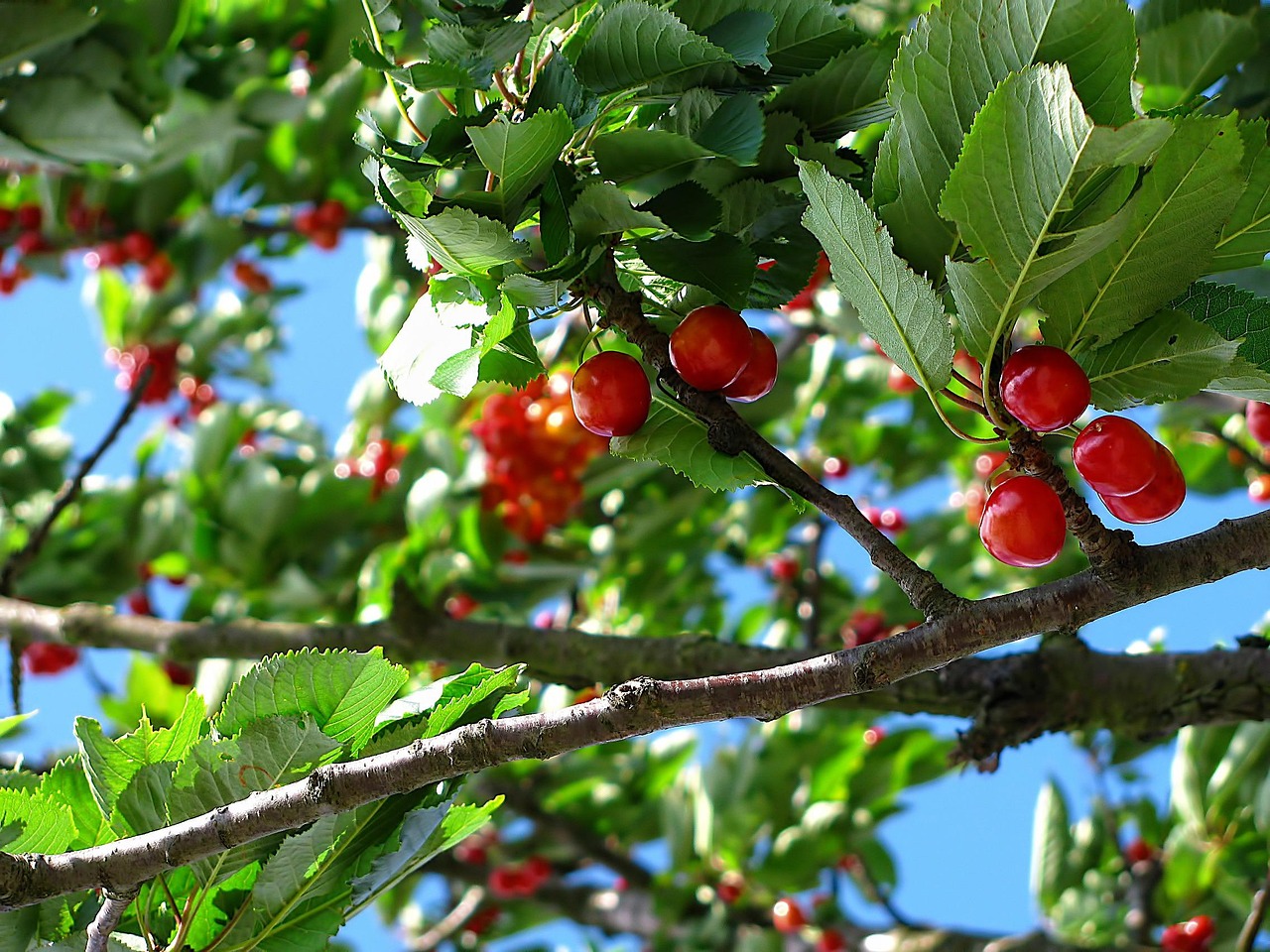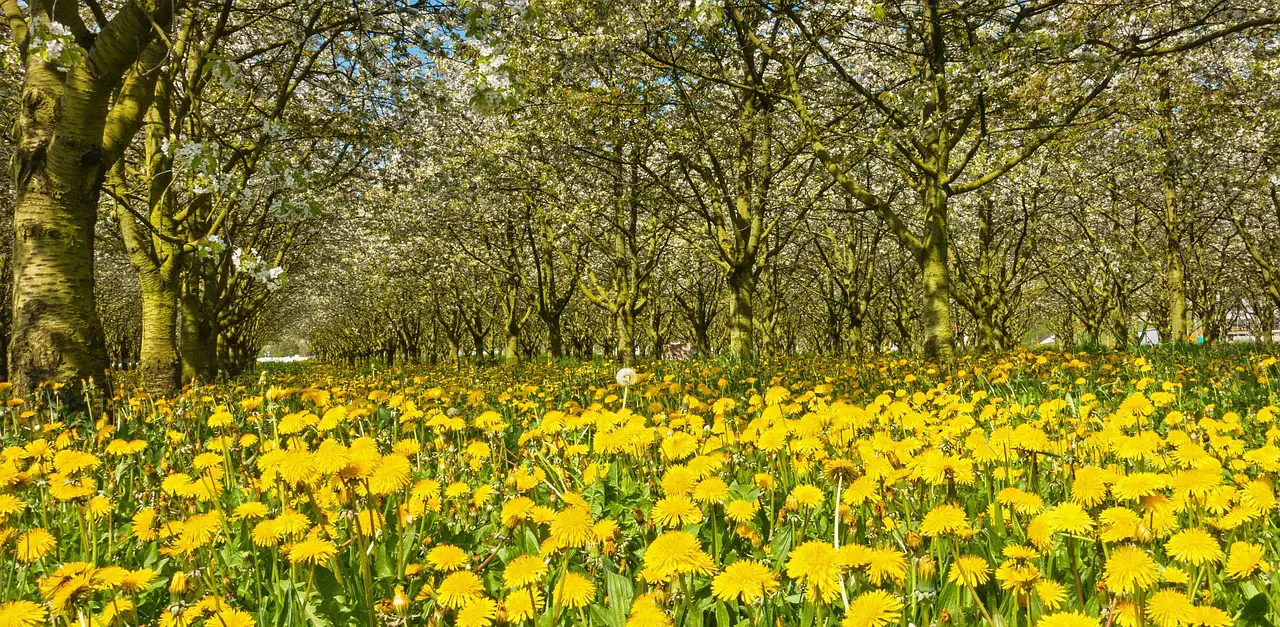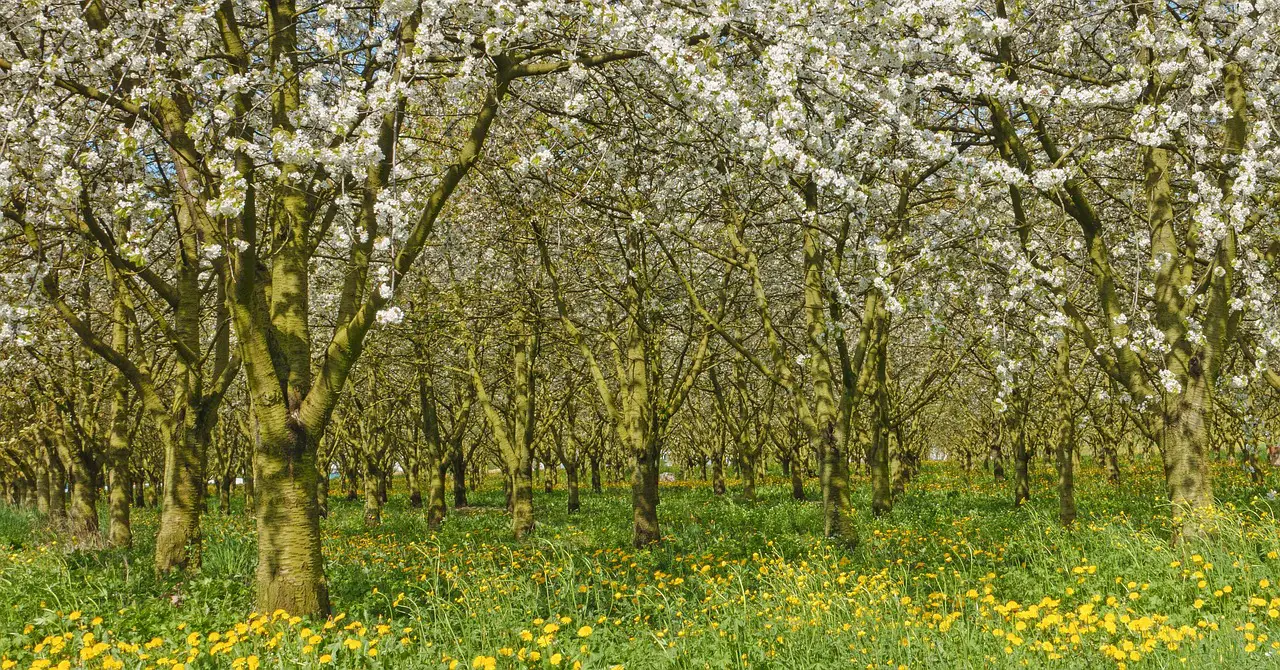Winter pruning techniques for cherry orchards focus on removing dead or diseased branches, shaping the tree, and promoting healthy growth. Proper pruning enhances fruit production and improves air circulation, which is vital for preventing fungal diseases.
Cherry trees, like many fruit-bearing plants, require careful management to thrive. One of the most crucial tasks is winter pruning. This process not only enhances the structure of the tree but also encourages better fruit yield in the upcoming season. Conducting pruning in winter allows gardeners to see the tree’s structure more clearly, as it is devoid of leaves. This visibility helps in making informed decisions about which branches to remove or maintain.

Effective winter pruning involves understanding the biology of cherry trees. These trees typically experience a dormant phase during winter, making it an ideal time for pruning. During dormancy, the trees are less susceptible to stress and can recover more quickly from cuts. Additionally, winter pruning can help prevent certain diseases that may affect cherry trees, ensuring a healthier orchard.
Benefits of Winter Pruning
Winter pruning offers several benefits for cherry orchards. Understanding these advantages can motivate growers to adopt this essential practice. Here are some key benefits:
- Improved Air Circulation: Pruning opens up the canopy of the tree, allowing better air movement which can reduce the risk of fungal diseases.
- Enhanced Light Penetration: By removing excess branches, sunlight can reach more parts of the tree, promoting even growth and ripening of fruits.
- Encourages New Growth: Pruning stimulates new growth in the spring, leading to a more vigorous and productive tree.
- Better Fruit Quality: With improved structure and light exposure, the quality of cherries can significantly increase.
To maximize these benefits, it is essential to understand the correct techniques for pruning cherry trees. Timing and method play a vital role in achieving the desired outcome.

Timing for Winter Pruning
The timing for winter pruning in cherry orchards is critical. It should typically be done when the trees are fully dormant, usually between late December and early March. However, local climate conditions can influence this timing. In regions with milder winters, pruning may be done earlier, while in colder areas, it should be delayed until late winter to avoid damage from frost.
Pruning too early can expose fresh cuts to cold temperatures, which may lead to dieback or other issues. Conversely, if done too late, it may interfere with the tree’s natural growth cycle as the sap begins to flow in early spring.
Essential Pruning Techniques
When it comes to winter pruning, several techniques can be utilized to ensure healthy growth and fruitful harvests. Here are some essential methods:

- Thinning Cuts: These cuts remove entire branches back to a lateral branch or bud. This technique helps improve airflow and light penetration.
- Heading Cuts: Heading cuts involve cutting back a branch to a bud or lateral branch, promoting bushier growth and encouraging new shoots.
- Removing Dead or Diseased Wood: It is vital to regularly inspect trees for dead, damaged, or diseased branches. Removing these enhances overall tree health.
- Crown Reduction: For overly tall cherry trees, reducing the height of the crown can help maintain manageability and encourage fruiting at lower levels.
Tools Required for Pruning
Having the right tools is essential for effective winter pruning. Below is a list of recommended tools:
| Tool | Description |
|---|---|
| Hand Pruners | Ideal for small branches and precise cuts. |
| Loppers | Used for cutting larger branches that are out of reach. |
| Saws | A pruning saw is necessary for thicker branches. |
| Safety Gear | Gloves and goggles protect against injuries during pruning. |
Using sharp and clean tools is important to make smooth cuts and reduce the risk of disease transmission between trees. Always disinfect tools before moving from one tree to another to prevent spreading pathogens.
In conclusion, winter pruning is an indispensable practice for maintaining healthy cherry orchards. By timing your efforts correctly and applying appropriate techniques, you can significantly improve the health and productivity of your cherry trees.

Common Mistakes in Winter Pruning
Winter pruning, while beneficial, can also lead to mistakes that may harm cherry trees if not done correctly. Understanding these common pitfalls can help orchardists avoid detrimental practices and ensure the health of their trees.
- Pruning at the Wrong Time: As mentioned earlier, timing is crucial. Pruning too early can expose trees to frost damage, while pruning too late can interfere with their growth cycle.
- Over-Pruning: Removing too many branches can stress the tree and reduce its fruiting capacity. It is important to maintain a balance between thinning and maintaining enough foliage for photosynthesis.
- Improper Cuts: Making jagged or too deep cuts can cause damage. Always use sharp tools and make clean cuts at the right angle.
- Ineffective Removal of Diseased Wood: Failing to properly remove infected branches can lead to the spread of diseases. Always cut back to healthy tissue.
Types of Cherry Trees and Their Pruning Needs
Different varieties of cherry trees have unique growth habits and pruning requirements. Understanding these differences is essential for effective winter pruning.
| Cherry Variety | Growth Habit | Pruning Techniques |
|---|---|---|
| Sour Cherry | Generally more bushy with a wide spread. | Focus on thinning out crowded branches and removing older wood to stimulate new growth. |
| Sweeter Cherry | Tends to have a more upright growth habit. | Encourage an open center by removing inward-growing branches. |
| Ornamental Cherry | Varies widely; often pruned for aesthetics. | Shape for beauty while ensuring health by removing dead or crossing branches. |
By recognizing the specific pruning needs of each variety, orchardists can tailor their techniques for optimal results in both health and productivity.
Signs Your Cherry Tree Needs Pruning
Knowing when to prune is just as important as knowing how. Here are some signs that indicate a cherry tree may need pruning:
- Excessive Crossed Branches: Branches that rub against each other can lead to wounds and increase the risk of disease.
- Reduced Fruit Production: If a tree produces fewer fruits than in previous years, it may need structural adjustments through pruning.
- Pest Infestation: If pests are frequently observed, it may indicate overcrowding or unhealthy growth areas.
- Dead or Diseased Wood: Any signs of decay, such as leaf discoloration or wilting, should prompt immediate attention through pruning.
Pruning Aftercare
Once pruning is complete, proper aftercare is essential to promote healing and growth. Here are several steps to follow:
- Seal Cuts (if necessary): In some cases, using a tree wound sealant can help protect cuts from infections, though this is debated among experts. Research local recommendations regarding sealants.
- Monitor for Pests: After pruning, keep an eye out for any pests that may be drawn to the tree due to exposed cuts or altered structure.
- Mulching: Applying mulch around the base of the tree can help retain moisture and suppress weeds, aiding recovery.
- Watering: Ensure the tree receives adequate water, especially during dry spells post-pruning, to support new growth.
Implementing these post-pruning care strategies will assist in nurturing the tree and helping it recover quickly from the stress of pruning.
Tools Maintenance for Effective Pruning
A well-maintained toolset is crucial for successful winter pruning. Here are some maintenance tips to ensure your tools remain in top condition:
- Regular Sharpening: Keep blades sharp for clean cuts, which minimizes damage to the tree.
- Cleansing Tools: After each use, clean your tools with rubbing alcohol or a bleach solution to prevent disease spread.
- Inspect for Damage: Regularly check tools for wear and tear. Replace any damaged parts to ensure safety and effectiveness.
- Proper Storage: Store tools in a dry place to prevent rusting and degradation.
By maintaining your pruning tools, you will enhance their longevity and ensure they perform effectively when needed most.
Consulting with Experts
If you are new to winter pruning or unsure about your techniques, consider consulting with local agricultural extension services or experienced orchardists. They can provide valuable insights specific to your region and the types of cherry trees you grow. Additionally, workshops and training sessions may be available in your area to further enhance your skills and knowledge.
The practice of winter pruning in cherry orchards is multifaceted. By understanding techniques, recognizing signs that necessitate action, and maintaining tools properly, orchardists can foster healthy and productive trees for years to come.
Pruning Techniques for Different Growth Stages
Cherry trees undergo various stages of growth, and each stage requires specific pruning techniques to maximize health and yield. Understanding how to effectively prune at different growth phases is essential for maintaining strong and productive trees.
Young Trees
When pruning young cherry trees, the goal is to establish a strong structure that will support future fruit production. Here are some key techniques:
- Establishing a Leader: Choose a single central leader branch and remove competing leaders. This helps create a strong, upright structure.
- Encouraging Lateral Branches: Allow several lateral branches to develop for a well-balanced canopy. Aim for branches spaced evenly around the tree.
- Thinning Out: Thin any overcrowded branches to improve light penetration and air circulation. This reduces competition for resources.
Mature Trees
Mature cherry trees require different pruning strategies to maintain health and productivity. Focus on the following:
- Renewal Pruning: Remove older branches that produce fewer fruits. This encourages new growth that will yield more fruit in the coming years.
- Maintaining Shape: Prune to maintain the desired shape of the tree. This helps prevent damage from wind or snow and keeps the tree manageable.
- Removing Suckers: Regularly remove suckers that grow from the base or along the trunk, as they divert energy away from productive branches.
Understanding Cherry Tree Growth Patterns
Cherry trees have distinct growth patterns that dictate how they should be pruned. Familiarizing yourself with these patterns can enhance your pruning effectiveness.
| Growth Pattern | Description | Pruning Implications |
|---|---|---|
| Open Center | This pattern creates a vase-like shape with branches growing outward. | Focus on thinning interior branches to maintain openness for sunlight and airflow. |
| Candelabra | This pattern features branches that grow upwards like a candelabra. | Maintain upward growth by selectively pruning lower branches, allowing light to reach all parts of the tree. |
| Central Leader | This pattern has a dominant central leader with lateral branches. | Ensure the leader remains the tallest branch and remove competing branches to support vertical growth. |
By understanding these growth patterns, you can tailor your pruning techniques to suit the natural tendencies of your cherry trees, promoting their health and productivity.
Pest and Disease Management During Pruning
Pest and disease management is another important aspect of winter pruning. Proper pruning techniques can help reduce the incidence of pests and diseases in cherry orchards. Here are some strategies:
- Identifying Pests: Regularly inspect trees for signs of pests such as aphids, spider mites, or borers. Early detection is key to effective management.
- Fungal Diseases: Common fungal issues include brown rot and powdery mildew. Pruning diseased branches promptly can prevent spread.
- Sanitation Practices: Clean up fallen leaves and debris around the orchard to reduce overwintering sites for pests and diseases.
- Use of Organic Treatments: Consider using organic solutions like neem oil or insecticidal soap as preventive measures against pests and diseases.
The Role of Soil Health in Tree Health
The health of cherry trees is closely linked to soil health. Pruning efforts can be complemented by good soil management practices. Here are a few important considerations:
- Soil Testing: Conduct soil tests regularly to determine pH levels and nutrient availability. This information can guide fertilization practices.
- Adding Organic Matter: Incorporating compost or well-rotted manure into the soil can improve soil structure and nutrient content.
- Avoiding Compaction: Limit foot traffic and machinery use around the root zone to prevent soil compaction, which can hinder root growth.
- Irrigation Management: Ensure trees receive adequate water during dry periods, as stressed trees are more susceptible to pests and diseases.
By ensuring that the soil conditions are optimal, you can support your cherry trees’ growth, making them more resilient to stressors such as pruning.
Winter Pruning Workshops and Resources
If you wish to deepen your understanding of winter pruning techniques, consider attending workshops or accessing online resources. Many agricultural extension services offer educational programs focused on fruit tree management. These resources can provide hands-on experience and expert advice tailored to your local conditions.
- Local Agricultural Extension Offices: They often provide free resources, workshops, and seminars on gardening techniques, including pruning.
- Online Courses: Websites like Coursera or Udemy may offer courses on pruning specific to fruit trees.
- YouTube Tutorials: Many experienced orchardists share their techniques through video tutorials, which can be beneficial for visual learners.
Engaging with these resources can lead to improved skills and knowledge in winter pruning, ultimately enhancing your cherry orchard’s productivity and longevity.
Advanced Pruning Techniques for Experienced Growers
For those with more experience in winter pruning, there are advanced techniques that can further improve the health and productivity of cherry orchards. These methods often require a deeper understanding of tree biology and growth patterns but can yield significant benefits.
Espalier Pruning
Espalier pruning is a technique that involves training trees to grow flat against a structure or wall. This method is particularly useful in small spaces and allows for better sunlight exposure and easier maintenance. Here are key points for successful espalier pruning:
- Choose the Right Structure: Use a trellis, wall, or fence to support the tree as it grows.
- Regular Shaping: Continually shape the tree by tying branches to the structure during its growth, ensuring they remain flat.
- Limit Growth: Focus on encouraging lateral growth while limiting vertical growth to maintain the desired shape.
Selective Thinning
Selective thinning involves removing specific branches to improve overall tree density and fruit quality. This technique allows light to penetrate deeper into the canopy and enhances air circulation. Consider the following when implementing selective thinning:
- Focus on Weak or Diseased Branches: Remove branches that show signs of weakness or disease to promote stronger growth.
- Aim for Balanced Canopy: Maintain a balanced canopy by evenly distributing remaining branches throughout the tree.
- Enhance Fruit Quality: Thinning can lead to larger, healthier fruits by reducing competition among fruit-bearing branches.
Training Young Trees for Optimal Shape
Training young cherry trees during their formative years is crucial for establishing a strong framework. This involves not only pruning but also guiding branch development. Key techniques include:
- Pinching Back: Pinch back new shoots to encourage branching and bushier growth.
- Use of Weights or Ties: Consider using weights or ties to gently bend branches into desired positions, promoting horizontal growth.
- Regular Assessments: Continuously assess tree growth and make adjustments as necessary to maintain the desired shape.
The Importance of Record Keeping
Keeping detailed records of your pruning activities can greatly benefit your orchard management. Here are some tips for effective record-keeping:
- Date of Pruning: Note when each tree is pruned to understand how timing affects growth.
- Branches Removed: Document which branches were removed and their condition to track health trends over time.
- Pest and Disease Observations: Keep notes on any pest or disease occurrences to identify patterns and adjust management practices accordingly.
Environmental Considerations
As you implement winter pruning techniques, it’s essential to consider environmental factors that may influence tree health. Factors such as climate, soil type, and local pests can all impact your orchard’s success. Here are some suggestions:
- Climate Adaptation: Choose cherry varieties that are well-suited to your local climate conditions. This can enhance resilience against extreme weather events.
- Sustainable Practices: Integrate sustainable practices like cover cropping and organic amendments to improve soil health and tree vigor.
- Pest Management Strategies: Use integrated pest management (IPM) techniques to minimize environmental impact while effectively managing pests and diseases.
Conclusion
Winter pruning techniques are vital for maintaining healthy cherry orchards. By employing the right methods, understanding tree growth patterns, and being mindful of environmental factors, orchardists can significantly enhance the productivity of their trees. Whether you are a novice or an experienced grower, ongoing education through workshops and resources can further refine your skills and ensure long-term success.
The key takeaways from this comprehensive guide include understanding the importance of timing, recognizing the specific needs of different cherry varieties, and implementing proper aftercare following pruning. By following these principles, you can create a thriving cherry orchard that yields abundant fruit year after year.
As you continue your journey in cherry orchard management, remember that each season presents an opportunity for learning and improvement. Embrace the practices that work best for your trees, and enjoy the rewarding experience of nurturing healthy cherry trees.
